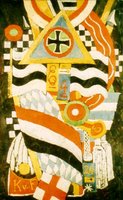 Marsden Hartley born 4 January 1877 (d. 1943)
Marsden Hartley born 4 January 1877 (d. 1943)Marsden Hartley was an American Modernist painter, poet, and essayist of the early 20th century. Hartley was born in Lewiston, Maine, USA, where his English parents had settled. He began his art training at the Cleveland Institute of Art after the family moved to Cleveland, Ohio, in 1892. He was born Edmund Hartley, but chose to take on his step-mother's maiden name, Marsden, as his first name.
At the age of 22, Hartley moved to New York City, where he attended the National Academy of Design and studied painting at the Art Students League of New York under William Merritt Chase. A great admirer of Albert Pinkham Ryder, Hartley would visit Ryder's studio in Greenwich Village as often as possible. While in New York, he came to the attention of Alfred Stieglitz and became associated with Stieglitz' 291 Gallery Group. Hartley had his first major exhibition at the 291 Gallery in 1909 and another in 1912. He was in the cultural vanguard, in the same milieu as Gertrude Stein, Hart Crane, Charles Demuth, Georgia O'Keeffe, Fernand Léger, Ezra Pound, Arnold Ronnebeck among many others.
 Hartley painted Portrait of a German Officer (1914), which was an ode to Karl von Freyburg, his friend Arnold Ronnebeck's cousin and a Prussian lieutenant of whom he became enamored before von Freyburg's death in World War I. The painting makes distinctive use of military symbols - including von Freyburg's initials - to suggest a human form. There has been much controversy over Hartley's adoption of Germany military symbolism in his art of this period - and of the nature of his relationship with Karl von Freyburg.
Hartley painted Portrait of a German Officer (1914), which was an ode to Karl von Freyburg, his friend Arnold Ronnebeck's cousin and a Prussian lieutenant of whom he became enamored before von Freyburg's death in World War I. The painting makes distinctive use of military symbols - including von Freyburg's initials - to suggest a human form. There has been much controversy over Hartley's adoption of Germany military symbolism in his art of this period - and of the nature of his relationship with Karl von Freyburg. Marsden Hartley travelled throughout the USA and Europe in the early years of the 20th century. Considered an early modernist, Hartley was a nomadic painter for much of his life. He painted from Maine to Massachusetts, in New Mexico, California, New York and Western Europe. Finally, after spending many years away from his native state, he returned to Maine toward the end of his life. He wanted to become 'the painter of Maine' and depict American life at a local level. In this way, he is a member of the regionalists, a group of artists from the early to mid 20th century that attempted to represent a distinctly 'American art'.
Marsden Hartley travelled throughout the USA and Europe in the early years of the 20th century. Considered an early modernist, Hartley was a nomadic painter for much of his life. He painted from Maine to Massachusetts, in New Mexico, California, New York and Western Europe. Finally, after spending many years away from his native state, he returned to Maine toward the end of his life. He wanted to become 'the painter of Maine' and depict American life at a local level. In this way, he is a member of the regionalists, a group of artists from the early to mid 20th century that attempted to represent a distinctly 'American art'.In addition to being considered one of the foremost American painters of the first half of the 20th century, Hartley also wrote poems, essays, and stories.
Cleophas and His Own: A North Atlantic Tragedy is a story based on two periods he spent in 1935 and 1936 with the Mason family in the Lunenburg County, Nova Scotia, fishing community of East Point Island. Hartley, then in his late 50s, found there both an innocent, unrestrained love and the sense of family he had been seeking since his unhappy childhood in Maine. The impact of this experience lasted until his death in 1943 and helped widen the scope of his mature works, which included numerous portrayals of the Masons.
 He wrote of the Masons, 'Five magnificent chapters out of an amazing, human book, these beautiful human beings, loving, tender, strong, courageous, dutiful, kind, so like the salt of the sea, the grit of the earth, the sheer face of the cliff.' In Cleophas and His Own, written in Nova Scotia in the fall of 1936 and re-printed in Marsden Hartley and Nova Scotia, Hartley expresses his immense grief at the tragic drowning of the Mason sons. The independent filmmaker Michael Maglaras has created a feature film Cleophas and His Own, released in 2005, which uses a personal testament by Hartley as its screenplay.
He wrote of the Masons, 'Five magnificent chapters out of an amazing, human book, these beautiful human beings, loving, tender, strong, courageous, dutiful, kind, so like the salt of the sea, the grit of the earth, the sheer face of the cliff.' In Cleophas and His Own, written in Nova Scotia in the fall of 1936 and re-printed in Marsden Hartley and Nova Scotia, Hartley expresses his immense grief at the tragic drowning of the Mason sons. The independent filmmaker Michael Maglaras has created a feature film Cleophas and His Own, released in 2005, which uses a personal testament by Hartley as its screenplay.